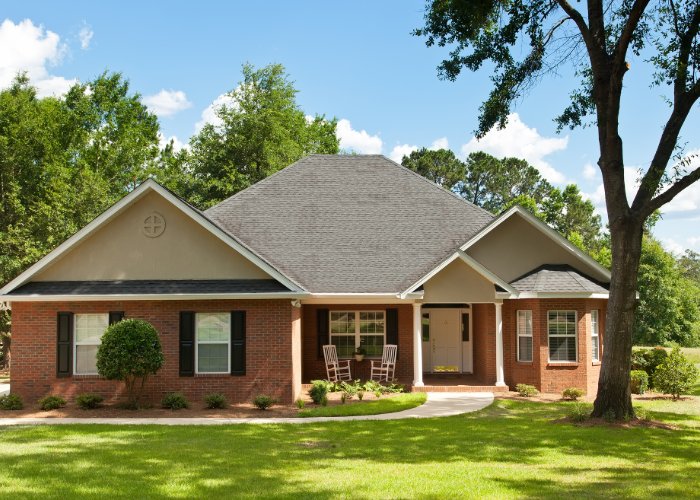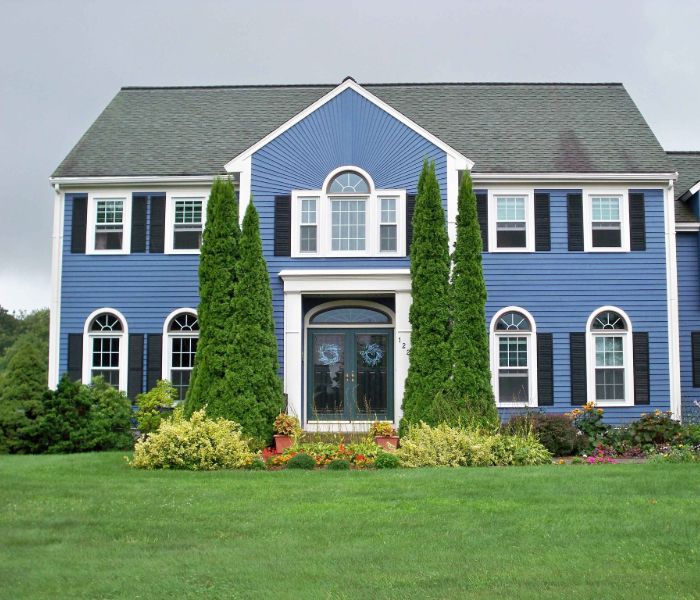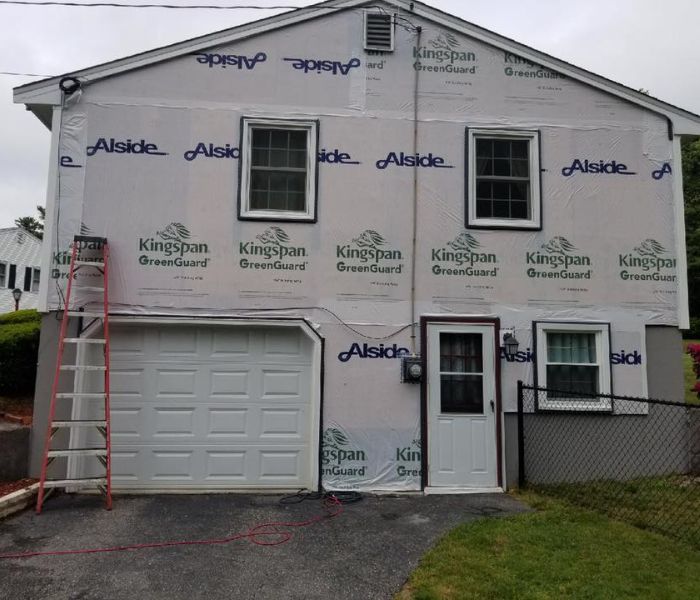Headquarters: 535 Pine Street, Central Falls, RI 02863
Call us: 401-274-0111
If you’re a homeowner asking “why is my house siding turning green,” the good news is that there are simple solutions to getting rid of that unsightly color and restoring your home’s siding. If you’re building a new home or are looking for a permanent solution to green stains and other wear outside your home, you might also consider various siding choices that help repel dirt and grime, and that stay looking their best for years.
To ensure your home’s exterior always looks its best, check out some suggestions for removing green discoloration safely and easily, and the best siding to choose for avoiding stains, rust, and other damage. Be sure to discuss this information with a home improvement contractor near you, so your home is always in good condition and looking its best!

The most common causes of house siding turning green are mold, algae, moss, and mildew growth, or grass clippings clinging to the home. While aluminum and vinyl siding don’t contain organic materials that feed these residues, they do provide a solid surface for them to spread and grow, leaving behind unsightly green or brown stains.
As you might know, mold and other pollutants grow much more quickly in humid environments and along damp surfaces, so it’s not unusual to see mold and algae growing along walls and roofs of homes in the tropics! Strong storms and heavy rainfall also keep outside surfaces damp and perfect for mold and algae growth no matter a home’s location.
If you have outdoor sprinklers that get the house wet, this can also encourage mold, algae, and other contaminants. Using a mower without a bag might also result in layers of cut grass clinging to your home, leaving behind unsightly green stains!
While any home can be prone to these residues and resultant stains, some materials such as wood siding are more hospitable to mold spores, algae roots, and moss and mildew growth. Some materials also stain more easily than others! While a homeowner can clean these stains as needed, investing in upgraded siding can mean avoiding that work and keeping the home looking its best year-round.
In the northern hemisphere, a home gets more sunlight along its southern side and less sunlight along north-facing walls and surfaces. In turn, your home’s north side might remain dark and shady even during sunny summer days!
Sunlight also helps dry out a home’s exterior surfaces; a lack of direct sunlight on north-facing walls means moisture such as morning dew clinging to those walls won’t evaporate easily. As mold, algae, moss, and other contaminants thrive in dark, damp areas, it’s not unusual to see moldy or otherwise stained northern-facing walls, even if the rest of the home’s walls and surfaces are mold-free.
Trimming back tree branches and shrubbery along the home’s north side can help allow more sunlight in this area. Upgrading to mold-resistant siding also means less risk of mold and algae growth. Otherwise, a homeowner might simply need to clean algae and mold off those walls regularly!
There are a few important reasons you’ll want to clean mold, mildew, and other irritants from siding as soon as possible. One vital reason is that they detract from your home’s appearance and make it seem rundown and dingy!
Another reason to tackle mold and mildew is that these contaminants are unhealthy for anyone and especially those with allergies and sensitivities. Mold and mildew also typically create unpleasant odors that make outside spaces unwelcoming and downright uncomfortable! If you love sitting out on a deck or patio or entertaining friends in the backyard, it’s vital you keep exterior walls clean and mold-free.
Mold and mildew also hold damaging moisture against outside walls. That moisture can soften brick and mortar or seep into small cracks of exterior siding, leading to interior water damage. Removing mold, mildew, moss, and other growth also removes that trapped moisture, protecting your home from damage.

Algae, mold, and other residues are cleaned easily with a bleach-based solution, although bleach does dry out wood siding and other surfaces. It’s vital you dilute bleach before applying it to siding; try one cup of bleach in five gallons of warm water and apply this to your home with a garden hose attachment. Allow it to sit for several minutes so it kills mold spores and other roots, and then scrub with a soft exterior scrub brush before rinsing.
If this doesn’t get rid of those green stains, try two cups of bleach in five gallons of water and keep adding more bleach to your solution as needed. It’s vital you scrub siding very gently as you work, to avoid pushing stains into its surface or spreading them to untouched areas! Ensure you also rinse the cleaned area thoroughly so there are no residues left behind.
Vinegar is another choice for killing and removing algae and other contaminants from outside your home. Use a 50/50 mixture of white vinegar and water and spray down the area, scrub it with your exterior cleaning brush, and rinse it thoroughly.
If this quick process doesn’t remove all the algae, you can try undiluted vinegar on the affected spots. Scrub and rinse it quickly, ensuring you reach all the nooks and crannies of exterior siding so you get all those roots and growth! Repeat this a few times as needed to get your home cleaned thoroughly.
Dish detergents are an excellent choice for cleaning dirt, mold, and grime from aluminum siding, brick, and other exterior surface materials. Grease cleansers like Dawn also work well to remove oily stains, such outdoor grilling residues, motor oil splatter, and the like.
It’s vital that you dilute your dish detergent in warm water before using it on the home; try a good squirt of the detergent in a gallon of warm water and spray this on the home, scrubbing as you go. Use warm water to rinse and note if the surface is as clean as expected; if not, try a bit more soap in the mixture and a higher pressure cleaner or more vigorous scrubbing!
You might have heard that pressure washing is bad for vinyl siding. Professional power washing is typically safe for siding, brick, roofing materials, wood decks and fences, and other surfaces, and can be a good choice for removing mold and algae if your home remedies aren’t successful. A professional power washing contractor will typically keep the risk of damage to a minimum, covering holes, damaged areas, and other spots that need protecting.
However, a homeowner would do well to avoid pressure washing a house themselves! Improper power washing techniques can mean ineffective cleaning and severe damage to a home’s exterior. Too much pressure, for example, can outright dent siding and create messy splatter along outside walls and nearby surfaces.
Professional power washing contractors also know the right cleansers to use for mold, mildew, algae, dirt, oily stains, and other residues. Using the wrong detergents can mean drying out your home’s exterior siding or leaving behind unsightly streaks. Failing to rinse that detergent properly can also result in a sticky residue that attracts even more dirt than before!

Clogged gutters are one common reason for mold and algae growth along a home’s exterior walls! Gutters collect rainwater and melting snow from the roof and direct that water to nearby downspouts, away from the home’s outside walls and foundation.
Rainwater washes over the sides of undersized or clogged gutters, running down exterior walls. All that moisture then encourages mold and algae growth. Keeping gutters clog-free and ensuring they’re sized properly for your area’s average weather conditions is an excellent way to reduce the risk of algae and mold along a home’s exterior walls.
Another option for stopping algae and other contaminants is to invest in siding that resists mold and other growth as much as possible. Brick has lots of small pits and pores that might hold moisture, encouraging mold growth. Wood siding is also less mold-resistant than other options, and both brick and wood are also less resistant to salt air and water damage than other siding options.
Vinyl siding is an affordable option for homes but it’s vital you invest in a reputable siding installer; improperly installed siding can mean more nooks and crannies that hold moisture, leading to water damage and mold growth. Steel and aluminum siding are also very mold-resistant, and both respond well to cleaning when needed.
Fiber cement is consider the most mold-resistant siding option. Fiber cement is composed of cement, sand, water, and cellulose fibers, for a very dense and durable yet lightweight siding option. Fiber cement is resistant to termite infestation, extreme temperatures, salt damage, and mold growth, and is also easy to clean and maintain over the years.
United Better Homes are proud to present this information to our readers and especially proud of the work offered by our Rhode Island home renovation contractors! If you’re still asking “why is my house turning green” or need new roofing or siding installation in Rhode Island give us a call. We carry only the most reliable, dependable name brand products and stand behind all our work with a guarantee you can trust.